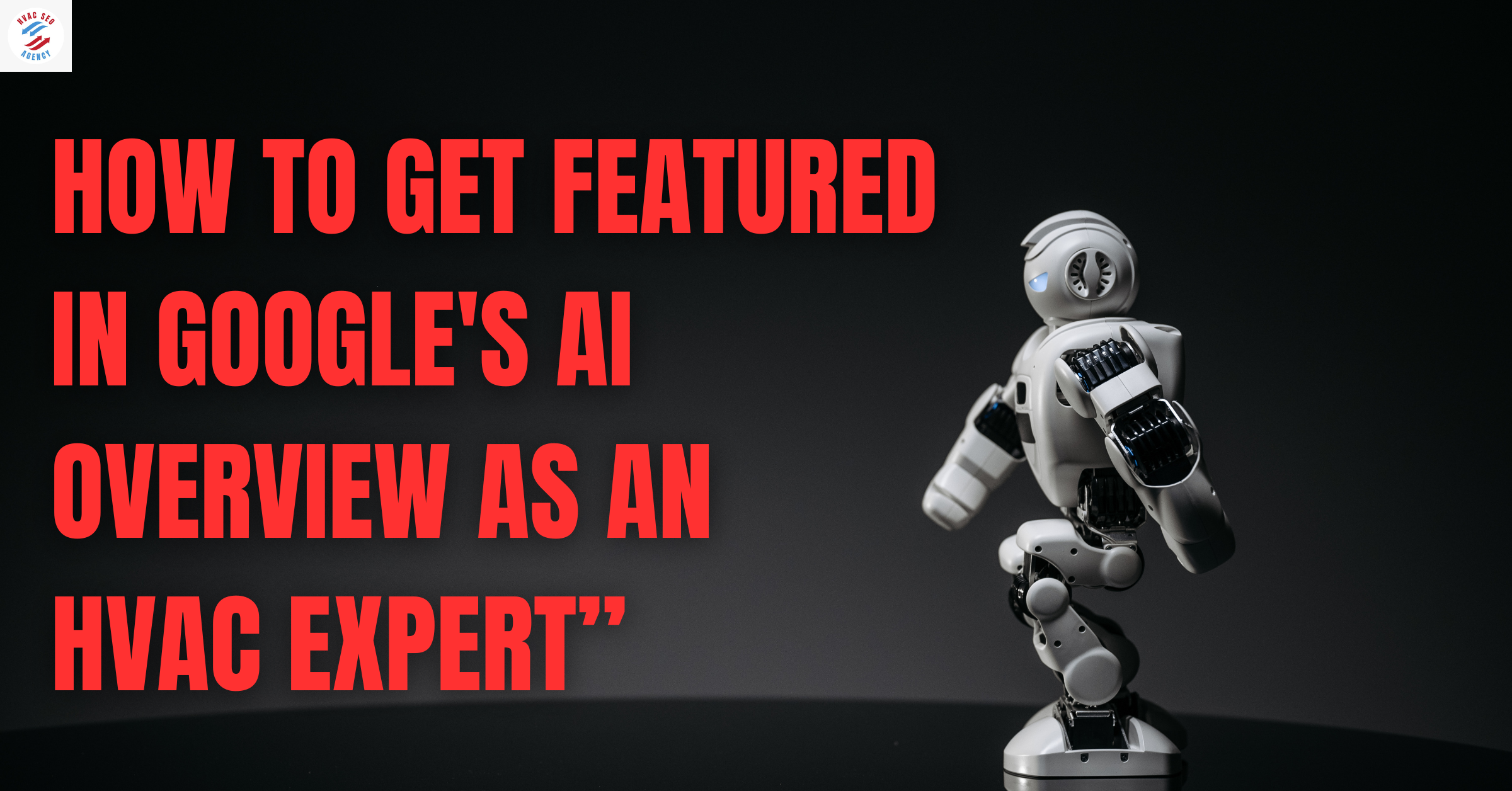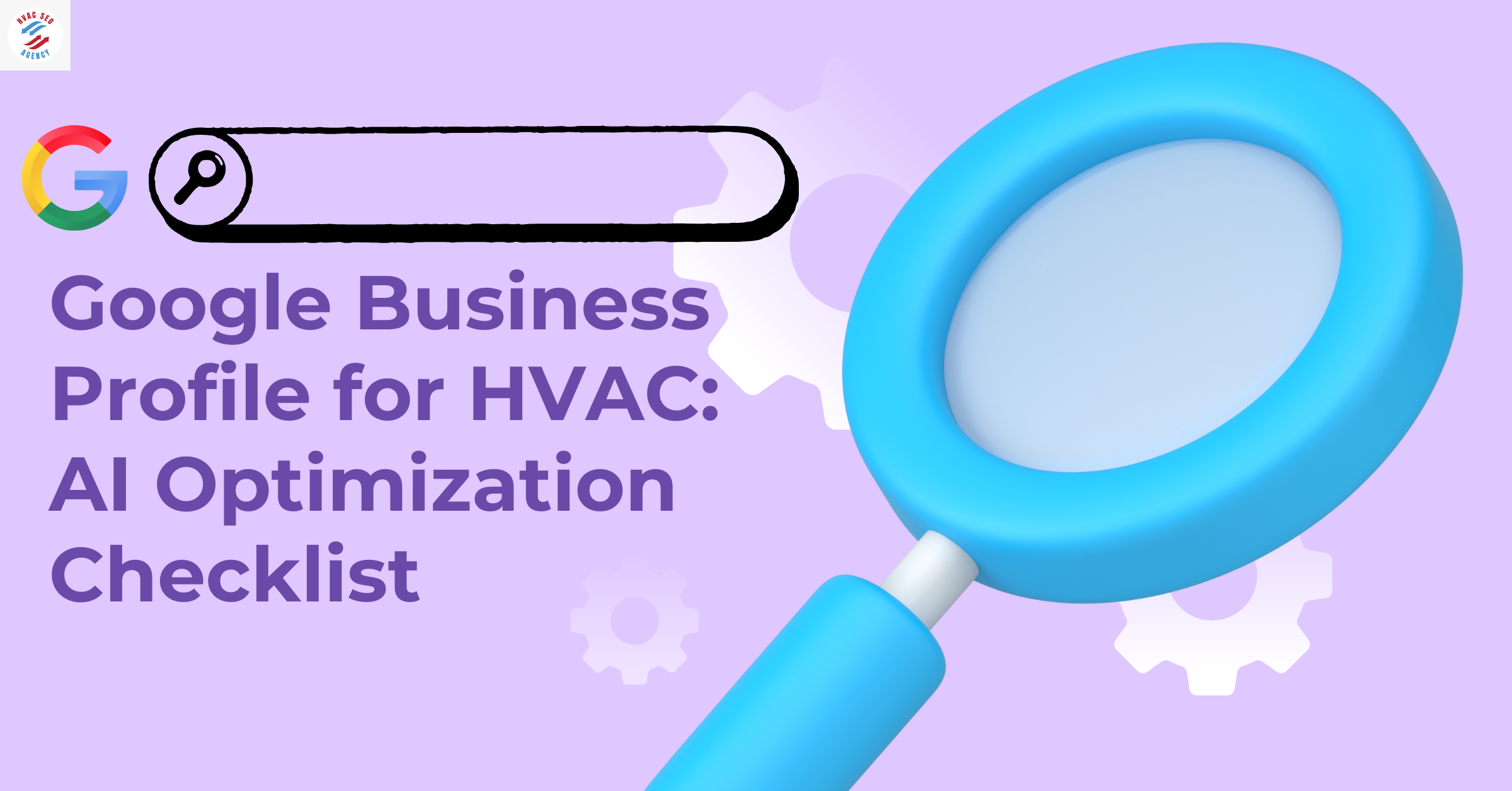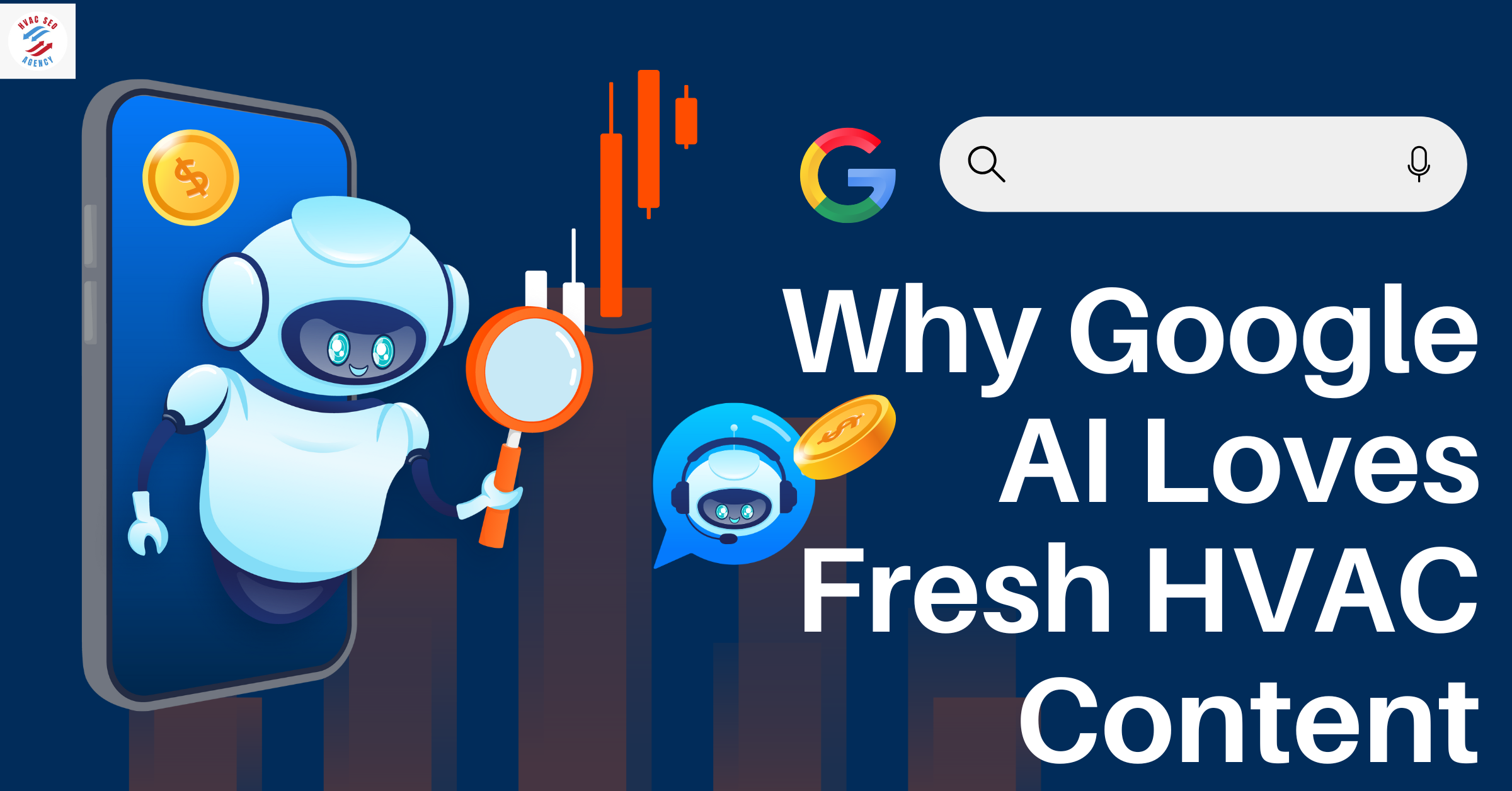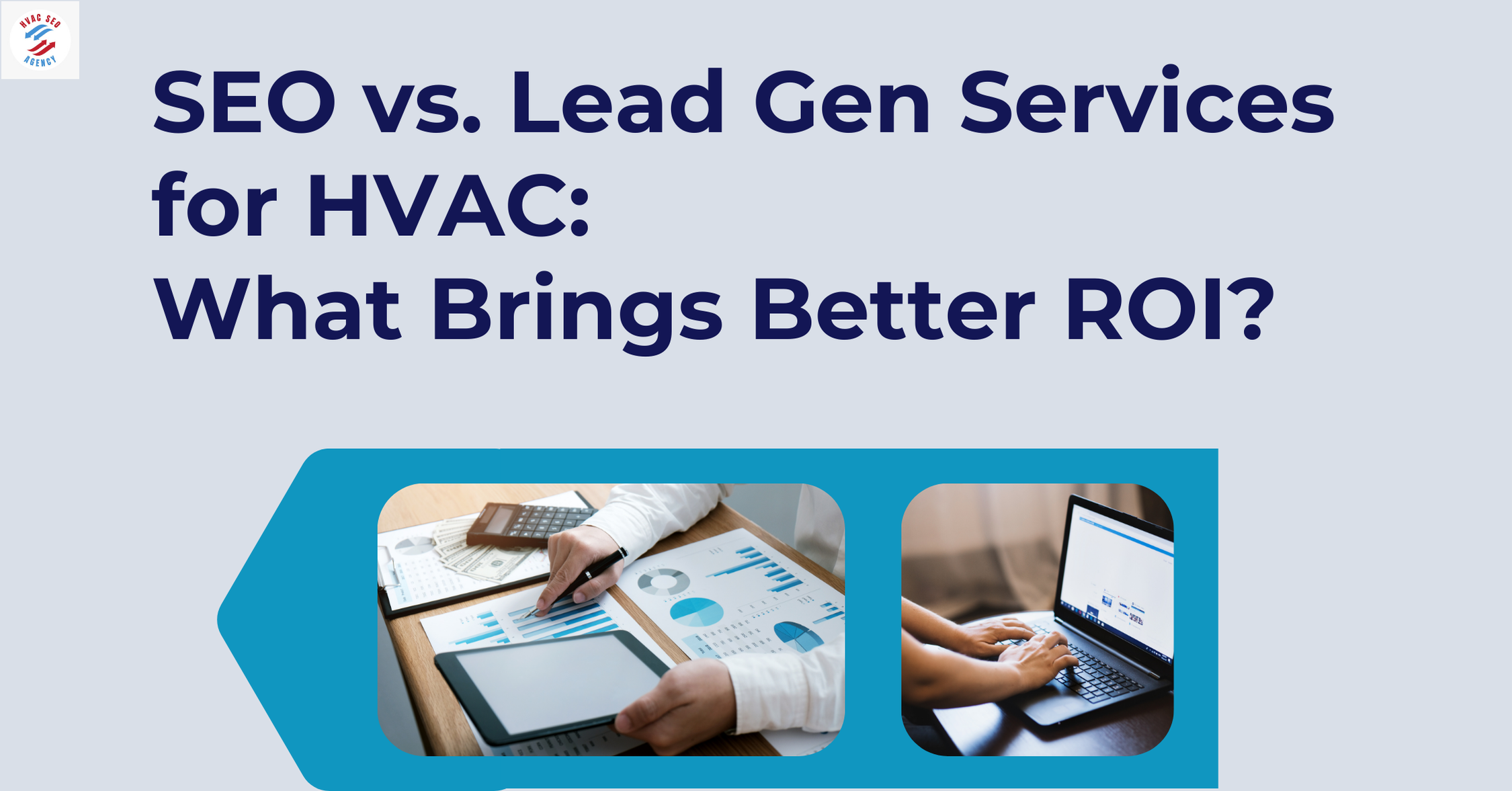The Role of Landing Pages in HVAC Lead Conversion
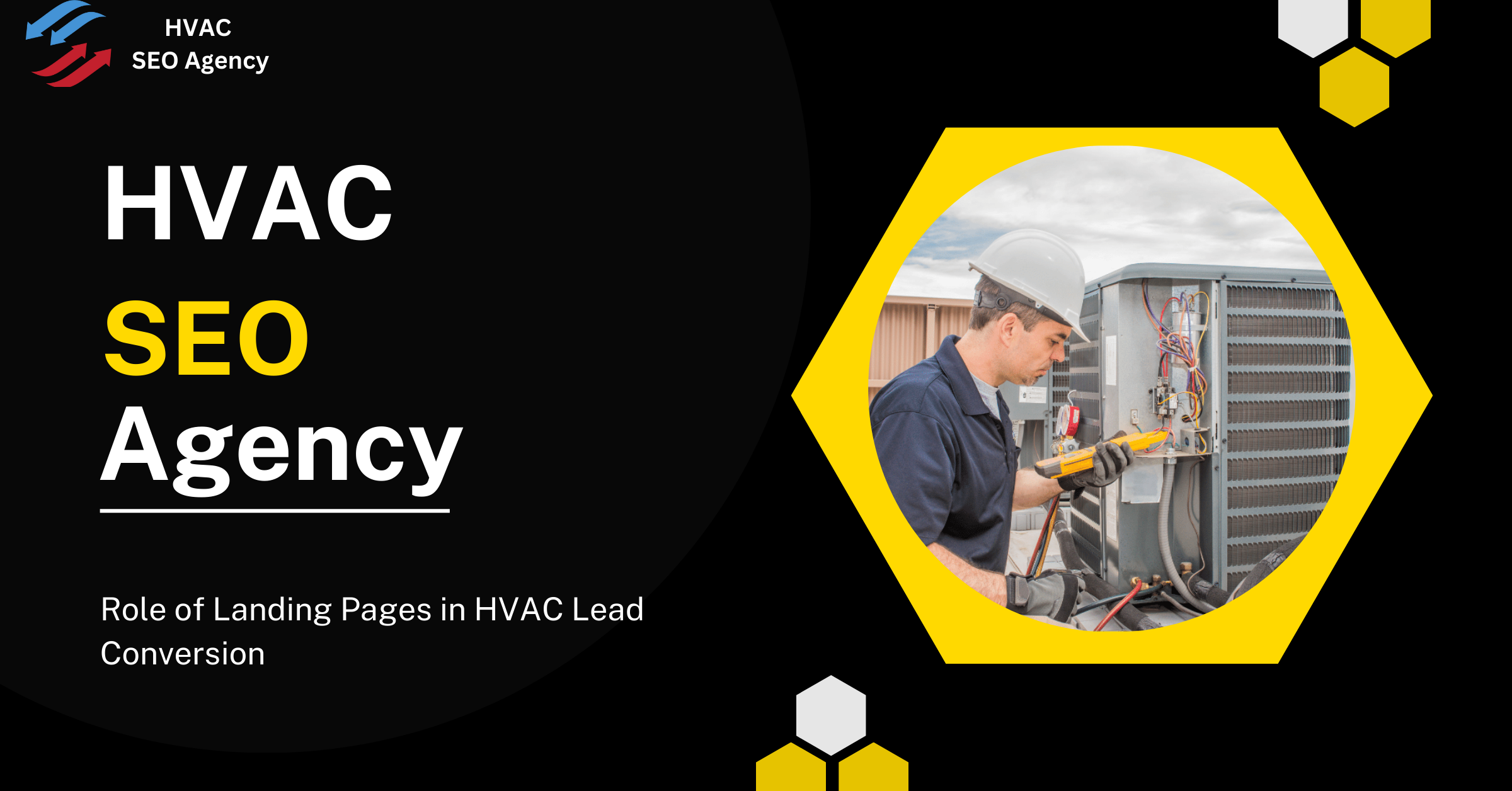
1.The Power of HVAC Landing Pages in Lead Conversion
In the highly competitive HVAC industry, simply having a website isn't enough to generate consistent leads and increase customer acquisition. Potential customers looking for HVAC repair, maintenance, or installation services expect quick, reliable, and highly targeted solutions when they land on a webpage. This is where HVAC landing pages best practices come into play.
A well-designed HVAC landing page serves as a 24/7 digital salesperson, guiding visitors toward booking a service or requesting a quote. Unlike generic homepages, a highly optimized landing page ensures that every element from the headline and call-to-action (CTA) to trust signals and mobile responsiveness works seamlessly to convert visitors into paying customers.
Additionally, working with an affordable HVAC SEO agency can ensure that your landing pages are fully optimized for search engines, helping you rank higher on Google, attract more local customers, and ultimately grow your business without breaking the bank. With strategic keyword placement, engaging content, and technical SEO improvements, an expert HVAC SEO agency can significantly improve your landing page's performance, reducing bounce rates and increasing conversions.
Why HVAC Businesses Need High-Converting Landing Pages
Unlike a homepage that provides broad information about your business, a landing page is a focused, high-converting tool designed for a specific HVAC service or promotion. Whether you’re targeting emergency AC repair, furnace installation, or seasonal maintenance, a well-optimized HVAC landing page ensures visitors take action leading to higher conversions and more booked jobs.
HVAC Landing Page vs. Homepage: Conversion Rate Comparison
Key Insight: Businesses using dedicated HVAC landing pages experience up to 5x higher conversions than those relying solely on a homepage.
The Science Behind HVAC Lead Conversion
Studies show that 48% of marketers believe landing pages are the best way to drive conversions. This is because most website visitors leave within 10-15 seconds if they don’t find what they’re looking for. A properly optimized HVAC landing page ensures potential customers immediately see the service they need, trust-building elements, and a compelling call-to-action (CTA) all within seconds of arriving on the page.
The goal of an HVAC landing page is to turn HVAC website visitors into paying customers by eliminating distractions and keeping the focus on a single service or offer. Whether it’s emergency AC repair, furnace installation, or seasonal maintenance, a strong landing page highlights why your HVAC business is the best choice with customer testimonials, industry certifications, and exclusive offers.
By implementing data-backed conversion strategies, such as A/B testing for CTAs, mobile optimization, and strategic keyword placement, HVAC businesses can increase lead conversions by up to 300%. Investing in a conversion-optimized landing page is the most effective way to capture high-intent leads and maximize revenue potential.
Key Benefits of HVAC Landing Pages
Higher Conversion Rates: Focused content with a single goal increases leads.
Better Local SEO Performance: Optimized pages rank higher for geo-targeted HVAC searches.
Improved PPC Campaign Performance: HVAC businesses running Google Ads see a 40% drop in cost per lead when using a well-optimized landing page.
Mobile-Friendly Lead Capture: With over 60% of HVAC searches happening on mobile, landing pages must be fast-loading and mobile-optimized to capture leads efficiently.
2. HVAC Landing Page Best Practices for Maximum Conversions
Creating an effective HVAC landing page requires strategic design, persuasive copy, and a seamless user experience. A well-optimized landing page should be built with the customer’s intent in mind, guiding them toward taking immediate action, whether it's scheduling a service, requesting a quote, or calling for emergency repairs.
One of the key lead sources for HVAC contractors is a highly targeted landing page that focuses on specific services such as air conditioning repair, furnace installation, or HVAC system maintenance. These pages should include compelling headlines, high-quality images, trust signals like customer reviews and certifications, and clear calls-to-action (CTAs) that prompt users to take the next step.
Additionally, HVAC landing pages must be fast-loading and mobile-optimized since more than 60% of HVAC searches come from mobile devices. A slow page can lead to high bounce rates and lost potential leads. Integrating geo-targeted keywords, trust badges, and contact forms ensures maximum engagement and higher conversion rates. By implementing these HVAC landing page best practices, contractors can significantly improve lead generation and increase revenue.
A High-Impact, Service-Specific Headline
Your headline is the first thing visitors see when they land on your page. It should immediately convey the value of your HVAC service and why the visitor should choose you.
Example of a High-Converting HVAC Landing Page Headline:
"Fast, Affordable HVAC Repairs in [Your City] – 24/7 Emergency Support"
Best Practice: Use power words like "fast," "affordable," "trusted," and "certified" to increase engagement.
Trust Signals & EEAT Compliance
Google prioritizes pages that demonstrate Expertise, Authority, and Trustworthiness (EEAT). Build trust with:
Customer Reviews & Testimonials (“500+ Satisfied Customers in [City]”)
Industry Certifications & Badges (NATE, BBB, ENERGY STAR, EPA-Certified)
satisfaction Guarantees (“100% Money-Back Guarantee”)
The Impact of Trust Signals on HVAC Landing Page Conversions
Your CTA should be clear, action-oriented, and strategically placed for maximum engagement.
Best CTA Practices for HVAC Landing Pages:
Above the Fold CTA: (“Get a Free Quote Now” – Visible without scrolling)
Urgency-Based CTA: (“Limited-Time Offer – Call Now!”)
Sticky Mobile CTA: (Click-to-Call for Instant Lead Capture)
Graph: Best CTA Placements for HVAC Landing Pages & Their Impact on Lead Generation
Visual representation of CTA placements & their conversion effects.
Mobile-Optimized & Fast-Loading Design
With 60%+ HVAC searches happening on mobile, a slow-loading or non-responsive landing page leads to lost business.
Quick Optimization Tips:
Use lazy-loading images to increase speed.
Compress large service images without compromising quality.
Avoid unnecessary pop-ups that disrupt mobile users.
Simple & Short Lead Forms
A common mistake HVAC businesses make is having a long, complex form that discourages users from completing it.
Best Practice:
Use 3-4 form fields max (Name, Phone, Service Type, Urgent/Not Urgent)
Geo-Targeting & Local HVAC SEO Optimization
To rank higher in Google’s local search results, your landing page must include:
City-Specific Keywords (“Best AC Repair in Miami”)
Embedded Google Map (Showing HVAC service area)
Local HVAC Schema Markup (Boosts Google visibility by 20%+!)
3. How HVAC Landing Pages Boost Local SEO & Google Rankings
For HVAC businesses, ranking high in local search results is critical to capturing ready-to-buy customers. A well-optimized HVAC landing page plays a direct role in improving Google rankings and increasing organic lead conversion.
How HVAC Landing Pages Influence Local SEO
When a potential customer searches for “HVAC repair near me”, Google prioritizes highly relevant, local landing pages over generic homepages. This is because Google’s local search algorithm favors:
Geo-targeted keywords
Consistent NAP (Name, Address, Phone Number) information
Google Business Profile (GBP) integration
Schema markup for HVAC services
Key Local SEO Strategies for HVAC Landing Pages
Geo-Targeting & Location-Based Keywords
To ensure maximum local visibility, HVAC landing pages must include geo-specific keywords in:
Page Title & Meta Description (Example: "AC Repair in Miami | Trusted HVAC Experts")
H1 & H2 Headings (Example: “Emergency HVAC Services in [City]”)
Service Descriptions (Example: “Our team provides expert AC installation in [City]”)
Google Business Profile (GBP) Integration
Linking your HVAC landing page to your Google Business Profile increases local search
rankings and drives direct calls & bookings. Ensure your GBP:
Has an accurate service area
Links to the correct landing page (not the homepage)
Includes updated customer reviews & ratings
Graph: The Impact of Localized Landing Pages on Google Rankings (Shows a ranking increase when HVAC businesses use geo-targeted landing pages vs. general service pages.)
NAP Consistency Across Directories
Google cross-checks your business information across multiple directories. Ensure your Name, Address, and Phone Number (NAP) is consistent across:
HVAC landing pages
Google Business Profile (GBP)
Local directories like Yelp, Angi, and HomeAdvisor
Table: The Impact of NAP Consistency on Google Map Rankings
HVAC companies invest heavily in PPC ads to generate leads, but ad spend can quickly become wasteful if the landing page isn’t optimized for conversions. A high-quality HVAC landing page improves Google Ads Quality Score, reducing cost-per-click (CPC) by up to 50% while increasing lead conversions. However, having an optimized landing page alone isn't enough. An HVAC business needs a strong Google My Business profile to maximize local visibility and ensure potential customers trust the brand before clicking on an ad.
When a potential customer searches for "HVAC repair near me," Google considers both landing page relevance and local business authority before ranking ads. If your Google My Business profile is complete with customer reviews, verified business information, and geo-targeted content, your HVAC landing page will perform even better in paid and organic search results. Combining a well-optimized PPC landing page with a strong GMB presence ensures higher conversion rates, lower ad costs, and more booked services.
How an Optimized HVAC Landing Page Lowers Ad Costs
Google assigns a Quality Score (1-10) to each PPC ad based on:
Ad relevance (Does the ad match the landing page?)
Landing page experience (Is the page fast, mobile-friendly, and conversion-optimized?)
Expected Click-Through Rate (CTR) (Does the ad attract high-intent users?)
Table: Google Ads Cost Reduction with an Optimized HVAC Landing Page
A well-designed HVAC landing page can attract visitors, but conversion rate optimization (CRO) ensures they take action whether it’s booking a service, requesting a quote, or calling your business. Even a 1% increase in conversion rate can mean thousands of dollars in additional revenue for HVAC businesses, making CRO a critical part of an effective lead generation strategy.
One effective way to boost conversions and retain customers is to build a customer loyalty program for HVAC businesses. Offering exclusive discounts, seasonal maintenance plans, or referral incentives can encourage repeat customers while improving landing page engagement. When visitors see membership benefits or discounted service plans, they are more likely to act immediately instead of leaving the page.
To further improve HVAC landing page CRO, ensure that the page has a clear call-to-action (CTA), trust signals like reviews and certifications, and a fast-loading, mobile-friendly design. Implementing A/B testing, live chat support, and interactive elements can also significantly increase conversion rates, ensuring that visitors turn into long-term, loyal customers.
How to Optimize HVAC Landing Pages for Maximum Conversions
To improve HVAC lead generation, businesses must focus on key conversion factors such as heatmap analysis, A/B testing, and psychological triggers.
Using Heatmaps & Analytics to Improve User Engagement
Heatmaps help track visitor interactions on your HVAC landing page to understand where users click the most and where they drop off.
Key Insights from Heatmap Tracking:
Are users clicking the CTA buttons?
Are they ignoring important sections?
Do they scroll past the most important offers?
Graph: Heatmap Example – Common Click Areas on an HVAC Landing Page (Visual representation of where users click the most.)
A/B Testing to Increase HVAC Lead Conversions
A/B testing (split testing) allows businesses to compare two versions of an HVAC landing page to determine which one performs better.
What You Should A/B Test:
Headlines – (e.g., "Affordable HVAC Services" vs. "24/7 Emergency HVAC Repairs")
Call-to-Action (CTA) Button Colors – (e.g., Red vs. Green)
Form Lengths – (e.g., 3 fields vs. 5 fields)
Images & Visuals – (e.g., Customer Testimonials vs. HVAC Technician Images)
Table: Impact of A/B Testing on HVAC Lead Conversion Rates
Psychological Triggers That Drive Action
Understanding consumer psychology can help increase HVAC landing page conversions by making small but impactful changes.
Key Psychological Triggers for HVAC Landing Pages:
Urgency & Scarcity: "Limited-Time Offer – Free HVAC Tune-Up!"
Social Proof: "500+ Homeowners in [City] Trust Our HVAC Services"
Authority Signals: Certifications like NATE, ENERGY STAR, and BBB Accreditation
6. The Role of Mobile-First HVAC Landing Pages in Lead Generation
More than 60% of HVAC searches happen on mobile devices, making mobile-friendly landing pages a necessity. If your HVAC landing page isn’t optimized for mobile users, you could be losing thousands of potential leads every month. A slow or poorly formatted page discourages visitors from taking action, increasing bounce rates and reducing conversion potential.
One of the key factors in sustained business growth is the importance of consistent HVAC lead generation. A mobile-first landing page ensures that potential customers can quickly navigate the site, click-to-call, and fill out service request forms without hassle. Fast-loading pages, thumb-friendly CTA buttons, and a simple design all contribute to higher engagement and conversions.
Additionally, integrating Google My Business (GMB) location data, mobile-optimized forms, and geo-targeted HVAC keywords can boost local search rankings and improve mobile ad performance. With the majority of HVAC customers searching on their phones, having a mobile-first approach is no longer optional; it's essential for long-term lead generation success.
Why Mobile Optimization is Critical for HVAC Landing Page Conversions
Google Prioritizes Mobile-Friendly Pages (Mobile-first indexing means Google ranks mobile-optimized pages higher.)
Mobile Users Prefer Click-to-Call Features (Most HVAC leads come from direct phone calls!)
Slow Pages = High Bounce Rates (A page that takes more than 3 seconds to load can lose up to 53% of mobile visitors.)
Best Practices for Mobile-Optimized HVAC Landing Pages
Click-to-Call CTAs for Immediate Lead Capture
Mobile users prefer quick solutions, and a visible click-to-call button can increase conversion rates by 40% or more.
Best Practices:
Place the click-to-call button at the top and bottom of the landing page.
Use bold colors for better visibility.
Ensure the phone number is linked for one-tap calling.
Fast Loading Pages for Higher Conversions
A 1-second delay in page load time reduces conversion rates by 7%. Ensuring fast-loading HVAC landing pages is non-negotiable.
How to Speed Up HVAC Landing Pages:
Enable lazy loading (Only loads images as users scroll.)
Use compressed images (Reduce file size without losing quality.)
Leverage browser caching (Saves elements to load pages faster.)
Table: Average Load Speed vs. Conversion Rate on Mobile Devices
Simple Forms That Convert
Long forms don’t work on mobile. Instead, keep HVAC lead capture forms short and to the point.
Best Practices for Mobile Forms:
3-4 fields max (Name, Phone Number, Service Type, Preferred Date)
Pre-filled fields for returning visitors
Auto-detect location for faster form submission
7. Common HVAC Landing Page Mistakes That Kill Lead Conversion (And How to Fix Them)
Many HVAC businesses struggle with lead conversion because their landing pages contain critical mistakes. Even minor issues such as slow load speed, poor design, or an unclear call-to-action (CTA) can lead to high bounce rates and low conversion rates. A poorly optimized HVAC landing page not only wastes marketing dollars but also loses potential customers to competitors.
One of the biggest mistakes HVAC companies make is not optimizing for mobile users, which results in poor user experience and lost leads. Another common issue is using generic, uninspiring headlines that fail to capture user attention. A lack of social proof—such as customer reviews, certifications, or trust badges can also make visitors hesitate before taking action.
To fix these issues, HVAC businesses should prioritize page speed, use clear, action-oriented CTAs, and incorporate social proof to build trust. Additionally, implementing A/B testing, reducing unnecessary form fields, and using strong, service-specific messaging can significantly increase conversion rates. By avoiding these common pitfalls and following best practices, HVAC companies can turn more website visitors into paying customers and maximize their digital marketing ROI.
Cluttered Layout and Too Much Information
A landing page should be simple and direct. If visitors see too much text or too many distractions, they may leave without taking action.
Solution:
Keep content concise and service-specific (e.g., "Same-Day HVAC Repairs in [City]").
Use bullet points to highlight key services and benefits.
Ensure the CTA stands out visually.
Table: Effect of Cluttered Design on HVAC Landing Page Performance
A weak CTA can confuse visitors and lower HVAC landing page conversion rates. If the CTA isn't clear, users won’t know what action to take.
Solution:
Make CTAs bold, large, and above the fold.
Use powerful CTA text, like:
“Schedule Your HVAC Service Now” instead of “Submit”Place multiple CTA buttons throughout the page.
Graph: Effect of CTA Optimization on HVAC Landing Page Conversions (Illustrates how proper CTA placement improves conversions.)
Slow Load Speeds Reduce Lead Conversion
A 1-second delay in page load time can drop HVAC landing page conversions by 7%! Google prioritizes fast-loading pages, especially on mobile devices.
Solution:
Compress images & use lazy loading.
Enable caching to speed up repeat visits.
Use a lightweight landing page builder.
Table: Page Speed vs. HVAC Landing Page Conversion Rate
To understand how HVAC landing page best practices improve lead generation, let's look at an HVAC company that increased its conversions by 300% in just six months. Before optimizing their landing page, this business struggled with low conversion rates, high bounce rates, and ineffective PPC campaigns. Their landing page had generic content, slow loading times, and an unclear call-to-action (CTA), leading to wasted ad spend and poor engagement.
After implementing key HVAC landing page optimization strategies, including faster page load speeds, trust-building elements (such as customer reviews and certifications), and stronger CTA placements, the company saw a dramatic increase in conversions. Additionally, by integrating geo-targeted HVAC keywords and optimizing their Google My Business profile, they ranked higher in local search results, leading to more organic traffic and lower PPC costs.
Within six months, this HVAC business saw a 40% decrease in cost per lead, a 3X increase in conversions, and a 50% improvement in user engagement. Their strategic landing page adjustments not only increased revenue but also positioned them as a leading HVAC provider in their market. This case study proves that a well-optimized landing page can transform an HVAC business’s online success and significantly boost lead generation efforts.
The Challenge: Low Conversion Rates & High Bounce Rates
Company: XYZ Heating & Cooling (Mid-sized HVAC company in Texas)
Problem:
Conversion rate was only 4%
High bounce rate (65%)
PPC ads were expensive, with $12 cost per click (CPC)
Table: Before Optimization vs. After HVAC Landing Page Optimization
The Solution: Optimizing Their HVAC Landing Page
XYZ Heating & Cooling worked with an HVAC SEO agency to implement the following landing page improvements:
Localized Keyword Optimization: Used city-specific terms like “AC Repair in Dallas – 24/7 Service”
Trust Signals: Added customer reviews & BBB accreditation badges
Faster Load Speed: Reduced page load time from 5.2 seconds to 2.1 seconds
Stronger CTA Placement: Changed “Submit” to “Get Your Free Estimate Today”
The Results: 3X More HVAC Leads & Lower PPC Costs
Within six months, the HVAC business experienced:
3X increase in lead conversions
40% drop in PPC cost per lead
More booked HVAC service calls & installations
9. Future Trends in HVAC Landing Page Optimization
The HVAC industry is evolving, and so are landing page optimization strategies. As Google’s algorithms, user behavior, and technology advance, HVAC businesses must adapt to stay competitive. A high-converting HVAC landing page will no longer be just about keywords and CTAs; it will require AI-driven personalization, voice search compatibility, and advanced mobile-first design to engage users and drive higher conversions.
One of the biggest future trends is the integration of AI-powered tools that can analyze user behavior in real-time and dynamically adjust content, CTAs, and offers to match visitor intent. Additionally, the rise of voice search means HVAC landing pages must be optimized for conversational queries, ensuring they appear for "near me" searches on smart devices.
Another key trend is the growing importance of interactive elements, such as live chat, cost calculators, and instant booking features, which keep visitors engaged and increase lead conversions. HVAC companies that embrace these innovations will gain a competitive edge, improve user experience, and maximize their digital marketing ROI in the years to come.
AI-Powered HVAC Landing Pages for Personalized Conversions
AI-driven tools are changing how HVAC businesses optimize landing pages. These tools analyze visitor behavior and dynamically adjust headlines, CTAs, and offers based on user intent.
Example of AI Implementation:
If a visitor has searched for "emergency HVAC repair", the landing page automatically updates to emphasize "24/7 Emergency Repairs – Call Now" instead of a generic "HVAC Services in [City]".
AI-powered chatbots engage users in real-time, increasing conversions by 20-30%.
Voice Search Optimization for HVAC Landing Pages
With the rise of smart speakers and mobile assistants, more users are searching for HVAC services using voice commands.
How to Optimize HVAC Landing Pages for Voice Search:
Use natural, conversational keywords (e.g., “Who provides the best AC repair near me?” instead of “Best AC repair”)
Structure FAQs in a direct Q&A format (Google loves this for Featured Snippets!)
Ensure Google My Business and HVAC landing pages are mobile-friendly.
Table: Growth of Voice Search Queries for HVAC Services
Static pages are becoming less effective. Users expect interactive elements like:
Instant HVAC cost calculators
Click-to-call buttons for mobile users
Live chat for immediate booking
FAQs
1. Why do HVAC businesses need dedicated landing pages instead of just a website?
A dedicated HVAC landing page focuses on a specific service, removing distractions and guiding users toward a single action (booking a service or requesting a quote). Unlike a homepage, it improves conversion rates by 3-5x and performs better for PPC campaigns.
2. What makes an HVAC landing page high-converting?
An HVAC landing page converts well when it includes a compelling headline, trust signals (like customer reviews and certifications), a clear CTA, fast load speed, and geo-targeted keywords.
Table: High-Converting vs. Low-Converting HVAC Landing Pages
3. How do I optimize my HVAC landing page for local SEO?
To rank higher in local searches, use geo-specific keywords, ensure NAP (Name, Address, Phone) consistency, integrate Google My Business, and add an embedded Google Map to your HVAC landing page.
4. How can I reduce bounce rates on my HVAC landing pages?
Reduce bounce rates by using a simple layout, fast load speeds, engaging visuals, strong CTAs, and reducing text clutter. Also, add an exit-intent pop-up with a discount offer.
5. Why is A/B testing important for HVAC landing pages?
A/B testing allows HVAC businesses to compare two versions of a landing page and determine which elements perform best. Testing different headlines, CTA placements, and images can improve conversion rates by up to 30%.
Conclusion: The Power of Optimized HVAC Landing Pages in Lead Conversion
In today’s competitive HVAC industry, simply having a website is no longer enough to generate consistent leads. A well-optimized HVAC landing page is the key to driving higher conversions, reducing bounce rates, and improving customer engagement.
By implementing HVAC landing page best practices, businesses can:
Increase conversion rates by 3-5x compared to generic service pages.
Lower PPC advertising costs by improving Google Ads Quality Score.
Enhance local SEO rankings by using geo-targeted keywords and structured data.
Improve mobile experience to capture over 60% of HVAC searches happening on smartphones.
The Future of HVAC Lead Generation
With the rise of AI-driven personalization, voice search optimization, and interactive landing page elements, HVAC businesses that adapt early will have the upper hand. As Google continues to prioritize user experience and localized content, investing in SEO-optimized landing pages is no longer optional; it's essential.
Key Takeaways for HVAC Business Owners
If your HVAC landing pages are slow, cluttered, or lack clear CTAs, you’re losing potential customers.
Invest in A/B testing, mobile optimization, and trust signals to see significant conversion improvements.
Regularly update landing pages with fresh content and customer reviews to maintain a high search ranking.
Prioritize local SEO strategies to dominate Google’s local pack and voice search results.


